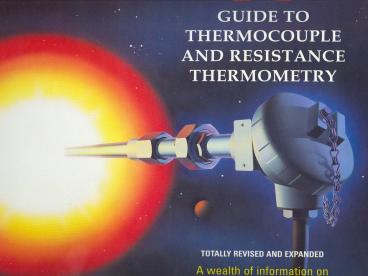Seebeck Effect - PowerPoint PPT Presentation
1 / 40
Title:
Seebeck Effect
Description:
Seebeck Effect ... The Thomson Effect concerns the reversible ... DVM: Digital Voltmeter. Isothermal: an electrical insulator but a good heat conductor ... – PowerPoint PPT presentation
Number of Views:2578
Avg rating:3.0/5.0
Title: Seebeck Effect
1
(No Transcript)
2
Seebeck Effect
- When two wires composed of dissimilar metals are
joined at both ends and one of the ends is
heated, there is a continuous current which flows
in the thermoelectric circuit. Thomas Seebeck
made this discovery in 1821.
T2
T1
3
A
T1
T2
B
B
- Emf
4
Peltier Thermal Effect
- When an electrical current flows across the
junction of a thermoelement pair, heat is
absorbed or liberated. - The current may be introduced by an external or
internal source such as a battery or Seebeck
effect respectively.
Eex
A
A
i
B
5
Thomson Effect
- The Thomson Effect concerns the reversible
evolution, or absorption, of heat occurring
whenever an electric current traverses a single
homogeneous conductor, across which a temperature
gradient is maintained, regardless of external
introduction of the current or its induction by
the thermocouple itself. - The Thomson voltage alone cannot sustain a
current in a single homogeneous conductor forming
a closed circuit, since equal and opposite EMFs
will be set up on the two paths from heated to
cooled parts of the circuit.
6
(No Transcript)
7
(No Transcript)
8
(No Transcript)
9
(No Transcript)
10
(No Transcript)
11
(No Transcript)
12
(No Transcript)
13
(No Transcript)
14
(No Transcript)
15
(No Transcript)
16
(No Transcript)
17
(No Transcript)
18
(No Transcript)
19
(No Transcript)
20
(No Transcript)
21
(No Transcript)
22
(No Transcript)
23
Law of Lead wire Temperature
The thermal Emf of a thermocouple with junctions
at T1 and T2 is totally unaffected by temperature
elsewhere in the circuit if the two metals used
are each homogeneous.
24
Law of Intermediate Lead wire Metal
If a third homogeneous metal, C, is inserted into
the circuit in either leg, the net ?Emf is
unchanged if the junctions to link C are held at
the same temperature. This ?is true regardless
of the temperature environment of link C .
25
Law of Intermediate Junction Metals
If a metal, C, is inserted at one of the
junctions between A and B, the net effect on ?the
Emf unchanged, if the junctions AB and AC are
held at the same temperature. ?This is true
regardless of the temperature environment along
link C.
26
Law of Intermediate Metal
?If the thermal Emf between metals A and C is
Eac, and that between metals B and ?C is Ecb,
then the thermal Emf between metals A and B is
Eac Ecb.?
27
Law of Intermediate Temperature
??If a thermocouple produces Emf E1 when its
junctions are at T1 and T2, and ?produces E2 with
junctions at T2 and T3, then it will produce E1
E2 when the ?junctions are at T1 and T3?.?
28
Measuring Thermocouple Voltage
we cant find the temperature at J1 unless we
first find the temperature of J2.
29
External Reference Junction
30
External Reference Junction-Type J
31
Removing Junctions from DVM Terminals
The absolute block temperature is unimportant
because the two Cu-Fe junctions act
in opposition. We still have
DVM Digital Voltmeter Isothermal an electrical
insulator but a good heat conductor
32
Eliminating the Ice Bath
33
Joining the Isothermal Block
We havent changed the output voltage V. It is
still
34
Joining the Isothermal Block
This is a useful conclusion, as it completely
eliminates the need for the iron (Fe) wire in the
LO lead
V a (TJ1 - TREF), where a is the Seebeck
coefficient for an Fe-C thermocouple. Junctions
J3 and J4, take the place of the ice bath. These
two junctions now become the Reference Junction.
35
External Reference Junction-No Ice Bath
Software Compensation
36
External Reference Junction-No Ice Bath
Why do we even bother with an thermocouple that
requires reference junction compensation?
- the RTD, and the integrated circuit transducer
are only useful over a certain temperature range.
- Thermocouples, on the other hand, can be used
over a range of temperatures, and optimized for
various atmospheres. - They are much more rugged than thermistors,
- In short, thermocouples are the most versatile
temperature transducers available and, since the
measurement system performs the entire task of
reference
37
Multi Thermocouple Configuration
38
Hardware Compensation
the electronic ice point reference
39
Practical Hardware Compensation
40
Voltage to Temperature Conversion































